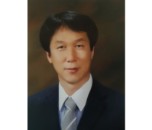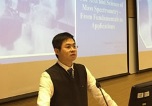Day 2 :
Keynote Forum
Athula Attygalle
Center for Mass Spectrometry, Stevens Institute of Technology, USA
Keynote: Where is the charge located in multifunctional gaseous ions? A survey by Ion Mobility Mass Spectrometry
Time : 08:30- 08:55

Biography:
Athula Attygalle is a reaech professor at Stevens Institute of Technology, USA. After an international scientific safari (University of Ceylon, University of Sri Lanka, Tokyo Institute of Technology, University of Keele, University of Erlangen-Nürnberg, and University of Houston), Attygalle became the Director of the mass spectrometry facility of Cornell University in 1991, After 12 years at Cornell, Attygalle became a Professor at Stevens Institute of Technology in Hoboken, NJ, in 2001. He has published over 200 papers in reputed journals and holds five U.S. patents.
Abstract:
The preferred charge sites of protonated or deprotonated molecules in the gas phase has been a topic of extensive research. In fact, the exact location of the initial charge site of the precursor ion is requisite that should be addressed before any pragmatic interpretation of a fragmentation spectrum is attempted. Although the challenge appears seemingly simple, in reality it is not at all a trivial problem. One often assumes that the charge location can be easily predicted by knowing the gas-phase acidity or basicity of various groups present in a polyfunctional molecule. However, in reality this a very challenging problem because generalizations valid for solution-based chemistry cannot be extended directly to gas-phase phenomena. For example, there is sufficient experimental evidence to demonstrate that deprotonated p-hydroxybenzoic acid exists in gas phase as a mixture of carboxylate and phenoxide forms. Analogously, protonated aniline exists as mixture of nitrogen- or ring-protonated forms. Ion-mobility mass spectrometry (IM-MS) provides a way to determine relative population ratios of protomers or deprotomers that coexist under mass spectrometric ion generation conditions. Employing IM-MS separation, we demonstrate that mass spectrometric source conditions used for gas-phase ion generation play an important role on the relative ratios of isomeric protomers and deprotomers that coexist under a specific set of experimental conditions.
Keynote Forum
Eduard Rogatsky
Wadsworth Center, USA
Keynote: Root causes of LC/MS data variability
Time : 08:55- 09:20

Biography:
Prof. Rogatsky serves as the Editor-in-Chief for the Journal of Chromatography and Separation Techniques (OMICS publishing group). During the last 10 years (from 2005) he has published over 30 scientific papers in per-reviewed journals (mostly as the first author) and has presented over 50 posters and lectures. Overall, he has made more than a hundred scientific presentations and publications. Eduard completed his M.Sc. in physical chemistry at Belarus State University (former USSR) in 1990. He completed his PhD in bioanalytical chemistry (Bar-Ilan University, Israel) in 1998. At the end of 1999, he started his post-doctorate at Albert Einstein College of Medicine and became a faculty member since 2001 and was a mass spectrometry director at the Biomarker Analytical Resource Core. From October 2015 Dr. Rogatsky is a supervisor of the Chemical Threat Laboratory in the Division of Environmental Health Sciences at Wadsworth Center, Albany NY, USA and continue to be an Adjunct Professor at Albert Einstein College of Medicine.
Abstract:
In a past decade in a literature were addressed different methodological questions, related to data variability between immunoassays and LC/MS methods (during clinical assay standardizations studies). However, reasons of inter-lab proficiency testing variability, performed only on LC/MS instruments typically are not discussed. While a pipetations inaccuracy limit is typically within 3% interval, reported proficiency testing results produced by well validated LC/MS methods, could be exceeding 20% bias or ± 3S consensus interval, even if the same method and same instrument brand were used in other laboratories. I present case studies demonstrating impact of calibration curve design, instrument settings, LC and MS instrumental conditions and analyte source chemistry on test results of specimens, blanks and quality controls.
Keynote Forum
Jianmin Chen
Fudan University, China
Keynote: Tropospheric multiphase chemistry elevated by diverse mass-spectrometric techniques
Time : 09:20- 09:45

Biography:
Jianmin Chen has completed his PhD at the age of 29 years from Fudan University. He is an atmospheric Scientist, distinguished professor and directors of Shanghai Key Laboratory of Atmospheric Particle Pollution and Prevention, and International Collaboration Base of Climate and Environment (Ministry of Science and Technology of China) at Fudan University. He was a visiting associate professor at University of Pittsburgh from 1996 to 1997, and regularly visiting scientist in Institut de Combustion Aérothermique, Réactivité et Environnement-CNRS. He has published more than 180 pre-reviewed papers in geoscience and chemistry journals such as Chem. Rev., J. Amer. Chem. Soc., Atmos. Chem. Phys., Environ Sci. Technol. and J. Geophy. Res., and serving as an associated editor of Sci. Total Environ., and board members of Aerosol Air Qual. Res., J. Environ. Sci. and Adv. Environ. Res.. He was honored as de chevalier dans l'ordre des palmes académiques, and the Enjoyment of the State Council of China special allowance in 2015.
Abstract:
Recently, multifarious mass-spectrometric techniques (MAF) have been rapidly developed and applied to tropospheric multiphase chemistry. They play an important role in the studies of secondary aerosol formation, chemical components, atmospheric oxidation, haze episodes and cloud condensation nuclei (CCN), which impact many aspects of air quality, health and global climate. Here, a variety of MST is introduced to investigate multiphase chemistry in ambient air and laboratory studies, (i) secondary organic aerosols (SOA) formation was investigated by single particle ToF mass spectrometry from α-pinene–ozone system with seed aerosols in an aerosol chamber; (ii) particulate nitrate formation was firstly explored by aerosol ToF mass spectrometry. High molecular weight species were observed in urban Shanghai aerosols; (iii) desorption electrospray ionization mass spectrometry has been applied for the first time to the analysis of SVOCs in atmospheric aerosols and only a 1 µL droplet sample is needed for analysis without or with little pretreatment; (vi) UHPLC coupled with Orbitrap MS was used in PM2.5 analysis. About 200 formulas of organosulfates, were found including dozens of formulas of nitrooxy- organosulfates with various numbers of isomers. It is increasing interest in MST combined with hygroscopic and optical techniques to explore atmospheric process and radiative forcing.
Keynote Forum
Ali Mohammad-Djafari
CNRS, France
Keynote: Inverse problems in Mass Spectrometry and Bayesian solutions

Biography:
Ali Mohammad-Djafari received the B.Sc. degree in electrical engineering from Polytechnic of Teheran, in 1975, the diploma degree (M.Sc.) from Ecole Supérieure d'Electricit(SUPELEC), Gif sur Yvette, France, in 1977, the "Docteur-Ingénieur" (Ph.D.) degree and "Doctorat d'Etat" in Physics, from the University of Paris Sud 11 (UPS), Orsay, France, respectively in 1981 and 1987.He was Assistant Professor at UPS for two years (1981-1983). Since 1984, he has a permanent position at "Centre national de la recherche scientifique (CNRS)" and works at "Laboratoire des signaux et systèmes (L2S)" at Centrale-Supélec. He was a visiting Associate Professor at University of Notre Dame, Indiana, USA during 1997-1998. From 1998 to 2002, he has been at the head of Signal and Image Processing division at this laboratory.
Abstract:
There have been recent advances in different techniques of Mass spectrometry. However, in many of these techniques there are common mathematical framework: Inverse problems. In this work, a few of these inverse problems are presented and an overview of the methods to handle them is given. The Bayesian inference approach is a very useful approach to handle these problems as it give the possibility to account both for prior modeling of the signals and images and for the uncertainly associated to the measurement process. It also gives the necessary tools to estimate the hyper parameters and the remaining uncertainties in the proposed solution. To illustrate this, we take the deconvolution problem which is one of the main inverse problems in mass spectrometry and go through the different regularization and Bayesian inference methods and compare their relative performances.
Keynote Forum
Achille Cappiello
LC-MS Laboratory, University of Urbino, Italy
Keynote: Liquid-EI interface: a new concept to enhance performance and stability in liquid chromatography-electron ionization mass spectrometry
Time : 9:30- 10:00

Biography:
Achille Cappiello is a professor of Analytical Chemistry at the University of Urbino in Italy, He studied at the University of Rome La Sapienza and after a two-year appointment as Post Doctoral Associate at the Massachusetts Institute of Technology, supervised by Professor Klaus Biemann, he began to engage in the field of LC-MS. Professor Cappiello is the director of several projects dealing with LC-MS instrument development and design with some of the major manufacturers. He published more than 100 scientific articles with an international circulation including the top journals in the field such as “Analytical Chemistry” and “Mass Spectrometry Reviews”.
Abstract:
A novel liquid chromatography-mass spectrometry (LC-MS) interfacing concept is presented and discussed. The new interface design is called “Liquid-EI”, LEI to distinguish it from previous attempts. In a LEI interface, vaporization of the HPLC eluate is carried out inside a suitable, independent micro-channel right before entering the ion source. An inert gas flow carries the gas phase molecules into the ion source. This approach moves the solute vaporization event immediately outside the ion source into a more suitable space in terms of dimensions, temperatures and surface materials, and free of sensitive components and electric potentials. The pressure drop and temperature gradients between LC and MS can be carefully monitored and controlled to enhance analyte response and reduce band broadening and/or solute carryovers. Preliminary results, carried out using an Agilent 7010 QqQ mass spectrometer and 5975 single quadrupole, gave us an optimistic impression, especially when the vaporization micro-channel was covered with a ceramic layer. Proof of concept and detailed description of the interface are presented. Preliminary experiments were conducted using PAHs (2-6 rings) and other compounds of environmental interest with and without column separation. Real world samples were analyzed using LEI with particular emphasis to address issues on identification of metabolites at low levels where mass spectral quality using high resolution accurate mass (HRAM) can be an issue and NMR may prove challenging, and further, complex sample matrix (soil, vegetable, food and other bio matrices, etc..) can give additional difficulties.
Keynote Forum
Wenjie Cao
SABIC Technology Center, Saudi Arabia
Keynote: From ESI to APCI, MMI and APPI, Complications of Adduct Ions on MRM at Different LC-MS/MS Ionization Techniques
Time : 9:00- 9:30

Biography:
Wenjie Cao received Ph.D. from Professor John Calvin Giddings’ Group at the University of Utah, Salt Lake City, UT. Contributor to the book of the Encyclopedia of Chromatography and more than 20 publications and presentations in peer-reviewed scientific journals and international conferences. Had worked for Huntsman Polymers Corp, Sealed Air Corp, and DuPont, as a Research Investigator, for 14 years in USA before joined SABIC in 2012. Now the Technical Leader of the Chromatography and Wet Lab and a Staff Scientist of the Analytical Department of the SABIC Technology Center at Riyadh, have filed six patents and delivered talks and made seminar presentations in the ISPAC Symposium 2016 and in King Saud University etc. since joint SABIC Technology Center.
Abstract:
This presentation is going to extend the comparison of ESI and APCI to MMI and APPI per some of the audiences’ request during the Q&A section of my presentation during the 2015 International Summit on Current Trend of MS in New Orleans. For the triple quadrupole LC-MS/MS instrument, the primary purpose or the most significant feature is the highest sensitivity among almost all, if not all, of the LC-MS/MS instruments by doing the Multiple Reaction Monitoring (MRM) testing. Ionization efficiency, selectivity, adduct ion production are among the top parameters which affect the MRM testing and the sensitivity. From ESI to APCI to MMI and APPI, this presentation will show the species and amount of adduct ions produced at each mode are quite different. Some type of the adduct ions may complicate the MRM testing by decreasing the sensitivities while some other adduct ions may prevent any reliable MRM tests being performed. Some examples will be presented to show how the typical adduct ions are produced in each mode from ESI to APCI and APPI, and how the typical adduct ions may complicate the MRM testing. The overall pros and cons, and the best ionization mode for some type of the targeted chemicals will be summarized for the different ionization techniques.
Keynote Forum
K.W. Michael Siu
University of Windsor, Canada
Keynote: Gas-Phase Dehydration of Protonated Polyglycines
Time : 9:30- 10:00

Biography:
Dr. Siu then accepted a position as Research Associate with the Division of Chemistry at the National Research Council of Canada. Over the following 16 years, Dr. Siu held positions with the NRC as Research Officer, Institute for Environmental Research and Technology (formerly Institute for Environmental Chemistry) and Senior Research Officer, Institute for National Measurement Standards. In 1998, Dr. Siu relocated to York University as Professor of Chemistry and NSERC/SCIEX (now AB SCIEX) Senior Industrial Research Chair in Analytical Mass Spectrometry. He was the Founding Director of the Centre for Research in Mass Spectrometry. Dr. Siu was named Distinguished Research Professor in 2007; in July of 2005, he accepted the first of two, three-year appointments as the Associate Vice-President Research, Science and Technology at York University. Dr. Siu is recognized globally as a leader in the fundamentals as well as applications in the field of mass spectrometry. He has coauthored more than 240 refereed articles, and he and his group have given in excess of 440 presentations of which 50% were in the invited, keynote or plenary category.
Abstract:
Loss of water is a common reaction after collisional activation of protonated polypeptides. We selected polyglycines as prototypical polypeptides for examination of the source of the water loss. Polyglycines labeled with 18O at specific peptide linkages were custom-synthesized using Wang resin. Protonated tetraglycine loses water predominantly from its first peptide linkage. Loss of water from the second peptide linkage increases in abundance with increasing peptide length, and becomes the predominant channel in hexaglycine. For tetraglycine, both density functional theory (DFT) calculations and infrared multiple photon dissociation (IRMPD) experiment strongly suggest that the dehydration product is formed by loss of water from the first peptide bond that results in a protonated imidazole-4-one (U.H. Verkerk et al. J. Phys. Chem. A 2011, 115, 6683; J.K.-C. Lau et al. Int. J. Mass Spectrom. 2012, 316, 268). Preliminary DFT and collision-induced dissociation (CID) results continue to support this structural interpretation for the dehydration products of pentaglycine and hexaglycine that involve loss of water from the first peptide bond. Those results that involve water loss from the second peptide bond suggest a series of rearrangement reactions prior to dissociation. Our results thus far indicate multiple pathways of polyglycine dehydration that are competitive.
- Applications of Mass Spectrometry | Recent Advances and Development in Mass Spectrometry | Hyphenated Techniques | Spectroscopy

Chair
Yang Pan
University of Science and Technology of China, China

Co-Chair
Joanna Fiedor
AGH-University of Science and Technology, Poland
Session Introduction
Youn Sung Kim
Samsung SDI, Republic of Korea
Title: Reviews of organic-assisted dissolution method to enhance the quantitative Analysis for the determination of hexavalent chromium (Cr(VI)) in polymer

Biography:
Dr. Kim begun his career with Samsung in 1989. He led the analysis team of Samsung Cheil synthetics from 1990 and 2000 and the analysis group of Samsung Cheil Industries from 2001 to 2015. Now, Dr. Kim served in Samsung SDI and in charge of DQC (Development Quality Control) part in automotive division. Dr. Kim work for IEC TC111 WG3 as experts related to develop new method to enhance recovery yield and extraction efficiency of IEC 62321 part.7-2 (hexavalent chromium) since 2009. Dr. Kim holds a doctoral degree in analytical chemistry from the University of Dankook in Korea.
Abstract:
An organic-assisted alkaline extraction method was developed for the determination of hexavalent chromium (Cr(VI)) in polymers. The stabilization of polymer as a pre-step of the alkaline extraction provided good extraction efficiency of Cr(VI)) from the sample. The optimization of the experimental conditions affecting the extraction and UV-Vis spectrophotometric analysis was accomplished by the evaluation the recovery rate of Cr(VI) through the analysis of Cr(VI) in in-house polymer reference materials. Also, we developed THF (Tetrahydrofuran)-assisted alkaline extraction method to determine Cr(VI) in the presence of Sb(III). The developed method suppressed the reduction by the formation of Sb(III)-THF adduct which was indentified by XRD, NMR and MALDI-TOF-MS. When applied to the in-house prepared reference polymers containing Sb(III), the method significantly enhanced the recovery to nearly 95 % from <3 % of the conventional extraction method. Low recovery of Cr(VI) due to the reduction to Cr(III) by Sb(III) has been an issue in the implementation of Regulation of Hazardous Substances (RoHS) directive.
Yang Pan
University of Science and Technology of China, China
Title: On-line photoionization mass spectrometry and its applications on catalysis, pyrolysis and matrices analysis

Biography:
Yang Pan has completed his PhD at the age of 30 years from University of Science and Technology of China. He is an associated professor of University of Science and Technology of China (USTC), and the director of the Mass Spectrometry Division of National Synchrotron Radiation Laboratory (NSRL) focusing on the development of photoionization mass spectrometric techniques. He has published more than 50 papers in reputed journals.
Abstract:
Photoionisation mass spectrometry (PIMS) has become a prominent technique for many years. Owing to its favorable characteristics (i.e., softness, no polarity discrimination, and reduced ion suppression) in contrast with other available ionization sources such as electrospray ionization, PIMS has been widely adopted by scientists for many mass spectrometric applications. Recently, PIMS has been applied for the online analysis of the chemical components and their highly dynamic processes during pyrolysis and combustion of various fuels. Compared with traditional “hard” electron ionization methods for the gaseous components analysis, photoionization produces little or no fragments, making the identiï¬cation and interpretation of complex ingredients in real-time possible. In this work, both commercial available discharge Kr lamp and synchrotron radiation with high brightness and wide energy spectrum were used as light sources for on-line PIMS studies, at the mass spectrometric end station of National Synchrotron Radiation Laboratory (NSRL) of China. Our work are mainly focused on three aspects: (1) heterogeneous catalytic reactions, such as Fischer-Tropsch synthesis and oxidative coupling of methane. (2) pyrolysis/combustion of biomass, municipal waste polymers, and cigarettes. (3) fast qualitative and quantitative analysis of chemicals in complex matrices, such as food, soil, and natural products.
Violetta V. Milyaeva
National Research Nuclear University MEPHI, Russia
Title: Compact laser mass spectrometer for techonological analysis of solids

Biography:
Abstract:
The new design of compact TOF mass spectrometer with laser ion source based on the wedge-shaped reflector is presented. For achievement of the best results during designing the instrument key problems are solved in two directions: 1) generation of ions; 2) separation by masses. Throughout the generation of laser plasma the differences in degree of ionization elements take place. This problem can be overcomed by choosing raised laser power density, that provides full ionization of all sample components, that are evaporated. Analytical signal is formed like a summing of single-charged and multi-charged ions. For levelling negative effects of wide spread by energy of ions the TOF analyzer with wedge-shaped reflector and integration mass spectrums in the total energy range is used. The proposed instrument is effective for analysis of solids and has extremely small overall dimensions. The detail project of mass spectrometer is analyzed, the key units are assessed. The competitive abilities in compare to spectroscopic analyzers are discussing.
Danuta Barałkiewicz
Adam Mickiewicz University in Poznań, Poland
Title: Multielemental speciation analysis of five toxic species: As(III), As(V), Cr(VI), Sb (III) and Sb(V) in drinking water samples by advanced hyphenated technique HPLC/ICP-DRC-MS

Biography:
Danuta Barałkiewicz teaches analytical chemistry at the Adam Mickiewicz University in Poznań and is the Head of the Department for Trace Elements Analysis by Spectroscopic Methods. She is an elected member of the Committee of Analytical Chemistry of the Polish Academy of Science. In her research, she applies advanced analytical techniques such as ICP-MS, HPLC/ICP-MS and LA-ICP-MS. She cooperates with representatives of various disciplines who are interested in environment, food, biology and medicine. She has been active in introducing metrology and chemometrics in analytical chemistry.
Abstract:
Multielemental determination of five toxic species: As(III), As(V), Cr(VI), Sb (III) and Sb(V) in drinking water samples using high performance liquid chromatography hyphenated to inductively coupled plasma mass spectrometry (HHPLC/ICP-DRC-MS)technique was developed. Optimization of the detection and separation conditions was conducted. Dynamic reaction cell (DRC) with oxygen as reaction gas was involved in the experiments. Obtained analytical signals for species were symmetrical, as studied by anion-exchange chromatography. Applied mobile phase consisted of 3 mM of EDTANa2 and 36 mM of ammonium nitrate. Full separation of species was achieved in 15 min with use of gradient elution program. Detailed validation of analytical procedure proved the reliability of analytical measurement. Obtained recoveries confirmed the lack of interferences’ influence on analytical signals as their values were in the range of 91%-110%. The applicability of the proposed procedure was tested on drinking water samples characterized by mineralization up to 7390 mg L-1.
Anissa Bendjeriou-Sedjerari
King Abdullah University of Science and Technology, Saudi Arabia
Title: “Catalysis by Designâ€: From Conventional Solid State NMR Spectroscopy to the Dynamic Nuclear Polarization Surface Enhanced Spectroscopy (DNP-SENS) - The Success Story of Single Site Well-Defined Heterogeneous Catalysts

Biography:
Dr. Anissa Bendjeriou-Sedjerari, Research Scientist at KAUST Catalysis Center (KCC, Director Pr. Jean-Marie Basset) was awarded a PhD in Materials Science from the University of Science and Technology of Montpellier (FRANCE) followed by postdoc positions at CALTECH and Ecole Normale Superieure de Lyon. Her main topics are the Designs and Characterizations of Heterogeneous Catalysts (FT-IR, Solid State NMR Spectroscopy, DNP-SENS...) applied to the C-H/C-C cleavage and activation (alkanes/olefins metathesis), CO2 activation etc. Her broad research interests have been published in numerous international journals. Besides, she is an active member of the MEPEC (Middle East Process Engineering Conference and Exhibition).
Abstract:
Heterogeneous catalysis is ubiquitous today and is central to solving many of the key problems facing chemistry including energy and environmental issues that contribute to a sustainable world. However, the main drawback is due to the multiplicity of active sites in terms of surface and bulk structure which makes it difficult to reflect the intrinsic efficiency of catalysts. The concept of “Catalysis by Design” requires the establishment of structure-activity relationship.[1] Surface Organometallic Chemistry (SOMC) thanks to its solid track record, provides a single-site strategy by creating well-defined surface organometallic fragments (SOMF) that are presumed to be part of the catalytic cycle. [1-3] To achieve this goal, the surface complexes need to be unambiguously characterized by advanced multi-dimensional solid-state NMR spectroscopy.[1-5] Recently, the sensitivity limitations encountered with the conventional solid state NMR spectroscopy have been overcome by the emergence of Dynamic Nuclear Polarization Surface Enhanced Spectroscopy (DNP-SENS) that requires the use of polarizing agent (radical nitroxide). [6-7] DNP-SENS can be now successfully applied to characterize highly sensitive SOMF in reasonable acquisition time. [8] By combining these essential and powerful spectroscopic tools, structure–activity relationships can be highlighted.
Joanna Fiedor
AGH-University of Science and Technology, Poland
Title: Total reflection X-ray fluorescence spectrometry (TXRF) as a convenient tool for quantification of biological samples

Biography:
Joanna Fiedor received her Ph.D. degree in Biochemistry at the age of 33 from the Jagiellonian University, Kraków, Poland. From 1997-1999 she worked at the Ludwig- Maximilians University (LMU) in Munich, Germany, and in 2002 at the Kwansei Gakuin University, Sanda, Japan. Currently, she is an Assistant Professor at the AGH-University of Science and Technology, Kraków, Poland. Her research interests are focused on natural biocompounds in relation to human health.
Abstract:
Total reflection X-ray fluorescence spectrometry (TXRF) is one of the well-established spectroscopic techniques used for elemental profiling of variety of samples. Among its major advantages the extension of the detection limit to one part per billion, simplicity of sample preparation along with the need of only 10-6 to 10-9 g of the material, and, eventually versatility of application should be highlighted. Apart from a number of non-biological studies, TXRF has been successfully used in medical, pharmaceutical, nutritional and other biologically-derived quantification analyses. However, not much has been done on bacterial systems. One of the few examples might be the examination of the ionome of phototrophic bacteria. Purple non-sulphur bacteria constitute a unique group of “photosynthetic” organisms capable of adjusting their metabolism in response to alteration of environmental growth conditions (light intensity, oxygen pressure). Recently, purple bacteria have attracted considerable attention due to their potential in a range of scientific and industrial applications. In view of the lack of consistent and systematic information on their microelemental content, the aims of the recent study were to qualify and quantify trace elements present in intact cells, bacterial phototrophic membranes and selected photosynthetic structures as well as to gain information on their distribution and mutual correlation in response to change in oxygen growth conditions. Finally, usefulness and vast analytical potential of TXRF was verified and confirmed.
- Fundamentals of Mass Spectrometry | Ionization Techniques

Chair
K W Michael Siu
University of Windsor, Canada

Co-Chair
Xinhua Guo
Jilin University, China
Session Introduction
Chi-Kit Andy Siu
City University of Hong Kong, China
Title: Discovery and mechanistic studies of an unusual remote radical-induced side-chain loss from tyrosine-containing peptide radical cations in the gas phase

Biography:
Chi-Kit Andy Siu received his PhD in Computational Chemistry from Chinese University of Hong Kong in 2003. After being a Postdoctoral Fellow at TU Munich (2003 – 2005, supported by Alexander von Humboldt Foundation) and York University (2005 – 2009), he joined City University of Hong Kong in 2009 and has become an Associate Professor since 2015. Dr. Siu is interested in the fundamentals of gas-phase ion chemistry, including structures of ions and their reaction mechanisms, thermodynamics, kinetics and dynamics at the electronic, atomic and molecular levels. He has published over 50 research articles on gas-phase ion chemistry.
Abstract:
Tyrosine is a constituent amino-acid residue of proteins. Because of the relatively low ionization energy of the aromatic phenol ring in its side chain, tyrosine is prone to be oxidized. The resulting one-electron oxidized tyrosyl radical is an important intermediate in many redox reactions of protein radicals. The intrinsic chemical properties of tyrosyl radical can be revealed from the fragmentations of tyrosine-containing peptide radical cations in the gas phase. The peptide fragments also provides invaluable sequence information that can be applied in mass spectrometry-based protein analyses. Upon ionization in the gas phase, a variety of tyrosyl radical tautomers can be generated and subsequently undergo radical-induced bond cleavages normally in the vicinity of the tyrosine residue. We have recently discovered an unusual radical-induced bond cleavage at the side chain of an amino-acid residue remote from the tyrosine. The plausible reaction mechanisms at the atomic and electronic levels have been examined experimentally using collision-induced dissociation for peptide models and their isotope-labeled and chemical derivatives and theoretically using density functional theory simulations.
Ivan K. Chu
University of Hong Kong, China
Title: Isomerization versus dissociation of phenylalanylglycyltryptophan radical cations

Biography:
Professor Chu’s group has been innovative in advancing the understanding of radical-mediated protein oxidation. Their pioneering studies of the molecular mechanisms of pathological processes under oxidative stress have extended to biophysical, bioanalytical, and biomedical applications and drug discovery. They have made many inroads implementing and applying new multidimensional liquid chromatography/mass spectrometric hardware for novel research purposes. A faculty member in the Department of Chemistry at the University of Hong Kong since 2002, Chu is an editorial board member for the Journal of the American Society for Mass Spectrometry, Journal of Mass Spectrometry, Mass Spectrometry Letters. His research into biological mass spectrometry has crystallized over 100 refereed articles.
Abstract:
Herein we report the propensity of radical migration and hence isomerization, or there lack of, in four tripeptide structures (FGW) that differ only in their initial radical locations: the π-system of Trp, the indole nitrogen, the α-carbon of Gly, and C-4 of the Phe ring. These radicals were generated by well-defined means and examined using tandem mass spectrometry. The π- and the N-radical centered on Trp interconvert after collisional activation; by contrast, the α-radical and the ζ-radical (on Phe) retain their distinctness even after collisional activation. Density functional calculations reveal a relatively low (31.1 kcal mol-1) barrier against interconversion between the π- and the N-radical, while interconversion between the α-radical and the ζ-radical exhibits much higher barriers, and these radicals will dissociate before they can interconvert. This study illustrates the intricate balance between radical migration and dissociation as exhibited by the four isomeric tripeptide radicals.
A.T. Hasan
American University of Sharjah, UAE
Title: Molecular ion collision chemistry in CH4 ionization and dissociation

Biography:
Abstract:
Although the phenomena of atomic collisions have been the subject of extensive research, much more can be learned about these complex and variant processes. Further experimental and theoretical studies of ion-molecule collision will provide a better understanding of the atomic structure, collision phenomena, and molecular ion formation. The use of the 90o hemispheric electrostatic high resolution analyzer [1] in conjunction with time of flight techniques allowed us to identify the various events associated with charged ion- molecular collision.
Xiaodong Zhang
The Australian National University, Australia
Title: Helix MC Plus high resolution noble gas mass spectrometer at the Australian National University

Biography:
Xiaodong Zhang completed his PhD in physics from La Trobe University in 1994. He has been working in noble gas mass spectrometry for 20 years. He is currently working in the noble gas laboratory at the Research School of Earth Sciences in the Australian National University. He has expertise in mass spectrometry, ultrahigh vacuum technology and laboratory automation.
Abstract:
The Helix MC Plus noble gas mass spectrometer manufactured by Thermo Fisher Scientific is a 350 mm sector, 120 degree, extended geometry, high resolution, multi-collector mass spectrometer for simultaneous acquisition of noble gas isotopes. The Helix MC Plus installed at the Australian National University (ANU) is unique in that it is equipped with three high resolution collectors with 0.3 mm defining slits on the axial (Ax), the high mass (H2) and the low mass (L2) detectors. In contrast, the H1 and L1 detectors are equipped with low mass resolution 0.6 mm collector slits. High mass resolution (>1,800) and mass resolving power (>9,000) achieved with the high resolution collectors make this mass spectrometer unique in analysing noble gas isotopes. It provides the capability to measure isobaric interference free noble gas isotopes in a multi-collector mode, which significantly improves the accuracy to determine isotopic ratios and greatly increases the efficiency of data acquisition. These features will be summarised in the presentation. The Helix MC Plus mass spectrometer at ANU is equipped with four movable detector modules, allowing the four detector positions (H2, H1, L1 and L2) to be adjusted. In order to measure a full suite of noble gases automatically from He to Xe, it is necessary to implement automation of detector positioning for each of noble gas element. This presentation will provide the details of the development of the detector automation currently carried out at ANU, including development of the motorised cup actuators, controller and the software.
Xinhua Guo
Jilin University, China
Title: Unusual Peptide Fragment Ions in Low-energy CID Process by Charge-Remote Fragmentation Pathways

Biography:
Dr. Xinhua Guo received her PhD in 2004 from University of The Sciences, US. Currently, she is a full professor at the college of chemistry, Jilin University, P. R. China. Her researches are focused on the development of various methods for structural studies and assemblies of DNA strands, new matrixes and materials for sensitive MALDI-MS analysis and studies of peptide fragmentation mechanism. She has published more than 30 scientific articles and held 2 patents. She was a member of council of Chinese Mass Spectrometry Society (CMSS) from 2008 -2016.
Abstract:
Several unusual peptide fragment ions including bn-44, cn and bn+H2O ions are initially observed in the MS/MS spectrum of a singly charged deuterohemine N-terminated peptide (DhHP-6, Deuterohemin-βAHTVEK-NH2). A detailed investigation on formation pathways of these characteristic ions are performed by using high resolution mass determination, H/D exchange, isotope labeling and density functional theory (DFT). Results indicate that the production of these ions is related to the presence of threonine (Thr) residue in the peptide. Also the N-terminal fixed charge carried by deuterohemine group may play a critical role for the activation of the hydrogen connecting with carbon, and McLafferty-type rearrangement reactions are proposed as the potential mechanism for explaining the generation of the bn-CH3CHO and cn ions. In this study, we also propose a rearrangement fragmentation pathway for the production of bn+H2O ions from the Thr/Ser residue. In that case, the N→O acyl shift occurs to generate an ester intermediate which is the first and the most critical step, following that a further fragmentation of the ester isomer leads to the formation of bn+H2O ions. Detections of these diagnostic ions from the MS/MS spectra of sodiated Thr containing peptides further support the proposed charge-remote fragmentation pathways. Present work provides mechanism insights into the production of special ions, such as cn and bn + H2O ions, in the low energy CID process.
Yuliya E. Silina
INM-Leibniz Institute for New Materials, Germany
Title: The key parameters impacted surface-assisted laser desorption/ionization-mass spectrometry

Biography:
Yuliya E. Silina has a doctorate in Analytical Chemistry. She is a principal investigator of a research team focusing on developments in microfluidics, test-methods of analysis, drug discovery, bio- and environmental sensing at Leibniz Institute for New Materials (Saarbrücken, Germany). She has published more than 30 papers in reputed journals and holds 11 patients for her inventions.
Abstract:
The developments within nanomaterial technology since almost 20 years caused an increased research output in many application fields including surface assisted laser desorption/ionization mass spectrometry (SALDI-MS). The study of the key parameters impacted SALDI-MS is of broad interest in the field of forensics, drug discovery, bio- and environmental analysis. Unfortunately, SALDI-MS still remains in some ways a kind of art due to multiple factors affecting desorption/ionization processes. Here we demonstrate how fundamental physicochemical parameters of materials such as conductivity, restructuring effects, surface acidity/basicity, morphology and thickness, light absorbance and presence of reagent ions impact the ion formation in atmospheric pressure laser desorption/ionization mass spectrometry (AP-LDI-MS). In addition, we will show how certain physical properties of the targets determine the crystallization properties of the analyte that eventually leads to the modified LDI-signal. Our findings were independently supported by means of Raman spectroscopy, Scanning Electron Microscopy, Transmission electron microscope, UV-and X-ray diffraction analysis. The obtained knowledge was applied for the synthesis of nanostructured targets for SALDI-MS allow profiling of regular and skimmed lactose-free milk samples without conducting the complex sample pretreatment and routine separation. The simplicity of this LDI-MS approach holds an excellent potential in applied research as a rapid instrument for efficiency/completeness of technological process control or detection of milk adulteration.
K.W. Michael Siu
University of Windsor, Canada
Title: Gas-Phase Dehydration of Protonated Polyglycines

Biography:
Dr. Siu then accepted a position as Research Associate with the Division of Chemistry at the National Research Council of Canada. Over the following 16 years, Dr. Siu held positions with the NRC as Research Officer, Institute for Environmental Research and Technology (formerly Institute for Environmental Chemistry) and Senior Research Officer, Institute for National Measurement Standards. In 1998, Dr. Siu relocated to York University as Professor of Chemistry and NSERC/SCIEX (now AB SCIEX) Senior Industrial Research Chair in Analytical Mass Spectrometry. He was the Founding Director of the Centre for Research in Mass Spectrometry. Dr. Siu was named Distinguished Research Professor in 2007; in July of 2005, he accepted the first of two, three-year appointments as the Associate Vice-President Research, Science and Technology at York University. Dr. Siu is recognized globally as a leader in the fundamentals as well as applications in the field of mass spectrometry. He has coauthored more than 240 refereed articles, and he and his group have given in excess of 440 presentations of which 50% were in the invited, keynote or plenary category.
Abstract:
Loss of water is a common reaction after collisional activation of protonated polypeptides. We selected polyglycines as prototypical polypeptides for examination of the source of the water loss. Polyglycines labeled with 18O at specific peptide linkages were custom-synthesized using Wang resin. Protonated tetraglycine loses water predominantly from its first peptide linkage. Loss of water from the second peptide linkage increases in abundance with increasing peptide length, and becomes the predominant channel in hexaglycine. For tetraglycine, both density functional theory (DFT) calculations and infrared multiple photon dissociation (IRMPD) experiment strongly suggest that the dehydration product is formed by loss of water from the first peptide bond that results in a protonated imidazole-4-one (U.H. Verkerk et al. J. Phys. Chem. A 2011, 115, 6683; J.K.-C. Lau et al. Int. J. Mass Spectrom. 2012, 316, 268). Preliminary DFT and collision-induced dissociation (CID) results continue to support this structural interpretation for the dehydration products of pentaglycine and hexaglycine that involve loss of water from the first peptide bond. Those results that involve water loss from the second peptide bond suggest a series of rearrangement reactions prior to dissociation. Our results thus far indicate multiple pathways of polyglycine dehydration that are competitive.
Yong-Xi Li
Medpace Bioanalytical Laboratories, USA
Title: Distributions of Nicotine and Cotinine in Rat Tooth, Alveolar Bone and Brain and their Impacts on Dental health

Biography:
Yong-Xi Li has completed his PhD in Beijing Institute of Petroleum Research in China and Postdoctoral training at Cornell University, USA. Currently he is Executive Director at Medpace Bioanalytical Laboratories focusing on bioanalytical analysis, including TK, PK, ADA and Nab method developments, validations and sample analysis for small molecule, polypeptides, protein and antibody therapies. He has published more than 100 papers and one book in reputed journals and publishing house and serving as one of organizers in a biotech conference.
Abstract:
Since Nicotine is like a neurotransmitter. With receptors they are involved in many functions in human. Rats were selected to simulate smokers, and distributions of Nicotine and Cotinine in tooth, alveolar bone and brain are investigated. Quantitative methods by LC-MS/MS are developed after extraction methods were established. Total of 18 SD rats had intraperitoneal injection once a day, then sacrificed after three months. Tooth, alveolar bone and brain were collected. Analytes and internal standards were extracted from tooth and alveolar bone using SPE procedure. Ground teeth was dissolved in HCl overnight. The analytes were spiked to liquidized tooth or bone for preparing calibration standards and QCs. Then neutralized sample was loaded on SPE, eluent was for analysis. Brain samples were homogenized, extracted using protein precipitation procedure. The LC-MS/MS analysis was carried out on Sciex 5500 LC-MS/MS system. The chromatographic separation was achieved on C18 column (100 × 2.1 mm) with gradient operation. The MRM transitions on +ESI mode were monitored at m/z 163.1 ® 130.1 for nicotine, m/z 177.1 ® 80.1 for cotinine. Calibration range was from 5 ng/g to 1,000 ng/g. Preliminary results have shown that under dosing of 0.8 mg/kg, the highest distributions are: 19.8 ng/g in teeth, 20.1 in alveolar bone and 11.5 in brain for Nicotine, and notably, 25.9 in teeth→58.4 in alveolar bone→103 ng/g in brain for cotinine. Compared to the results from smoker teeth, the impacts on dental health are discussed from cotinine deposition acumination, and as well as brain neuro system.
Julien Keraudy
University of Nantes, France
Title: Mass spectrometry diagnostics in highly ionized plasma: a key tool to optimize the sputtering process and the film growth

Biography:
Julien Keraudy was born in Brest, France, in 1989. He received the M.Sc. degree in physics and the Magister science from the University of Rennes, Rennes, France, in 2012, and the Ph.D degree in physics from the University of Nantes, Nantes, France in 2015. He is currently a Post-Doctoral Fellow in the division of Plasma & Coatings physics, Department of Physics, Chemistry and Biology (IFM), Linköping University, Sweden, where he is involved in plasma diagnostic and growth of thin films deposited by HiPIMS discharge.
Abstract:
High power impulse magnetron sputtering (HiPIMS) is a new method for physical vapor deposition (PVD) based on magnetron sputtering. It utilizes transient impulse (short pulse) glow discharges with very high power and current density (up to 3 kW cm-2 and 4 A cm-2 respectively at a duty cycle of < 5%). Under these conditions the plasma density near the target increases sufficiently to ionize a significant proportion of the sputtered metal ions thus creating a high-efficiency metal ion source. Compare to conventional processes, HiPIMS discharges give increased possibilities to use ionized the metal flux for bombardment but have also demonstrated to be an elegant solution for controlling the chemical composition, energy and trajectory of the ion current arriving at the film growth surface. This fine control of the metal ion flux has found plenty of applications for cutting tools, especially for deposition on complex geometries, enhancement of the adhesion between coatings and substrates, enhancement of the optical films properties, substrate pre-treatment for anti-corrosion coatings, and more recently for the low-temperature epitaxial growth of nitride coatings on MgO substrates. These achievements have mainly been possible thanks to a detailed comprehensive study of the plasma-surface interaction phenomena, especially at the plasma-growing film interfaces. Among the most common plasma diagnostic methods, mass spectrometry is proven to be a powerful tool to monitor the ion dynamics in HiPIMS discharges by examining the ion energy distribution function (IEDF). Through the presentation of different examples of innovative coatings as well as low-temperature epitaxial growth, the benefits of mass spectrometry in highly ionized plasma will be presented.
